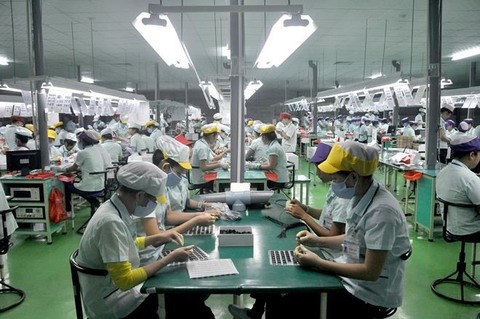Skill-powered growth for Vietnam’s 4.0 economy
Skill-powered growth for Vietnam’s 4.0 economy
Within three decades, Vietnam has performed an economic miracle in rising from one of the world’s least-developed nations into a lower middle-income country. To tap into the full potential of Vietnamese economic prowess and also unleash advantages brought about by Industry 4.0, developing a national skills eco-system is paramount. Anderson Tan, chairman of SkillsSG Ventures, digs into the issue.
Vietnam, through the economic and political reforms that took place from 1986 under doi moi, has been able to transform from one of the world’s least-developed nations to a lower middle-income country, all within the space of three decades. However, to sustain this momentum on growth and propel the country further, future investments must be focussed on the development of human capital in order to utilise the full potential of the nation’s economic prowess.
Doi moi has created a stable and attractive platform for significant inflow of foreign direct investment (FDI) since 1987. Strategies based on offering progressive government policies, fiscal and land incentives, as well as low-cost labour have worked well over the past few decades in attracting manufacturing and infrastructural investments into the country. However, with the variety, velocity and volume of changes that are impacting ASEAN, new socio-economic strategies are needed.
China’s Belt and Road Initiative, along with the on-going trade clash between the US and China, is shifting trade and production patterns in favour of Vietnam. The Comprehensive and Progressive Agreement for Trans-Pacific Partnership, and EU-Vietnam Free Trade Agreement, once ratified and put into action, will open up even more channels of trade. These agreements will translate into new opportunities for Vietnam, bringing with them the advent of Industry 4.0 into the economic base.
Industry 4.0 refers to a collective of advanced manufacturing that includes digitalisation, the Internet of Things, automation, robotisation, machine learning, and artificial intelligence. It promises to bring with it tremendous wealth creation for countries that are able to embrace it; but conversely it threatens to disrupt conventional economic structures that are slow or resistant to adopting it.
As the Vietnamese government tries enthusiastically to attract more foreign investors, the same investors are increasingly questioning whether they have access to the skilled labour needed. While the government might invest more in higher education, it is becoming increasingly challenging to make graduates more employable and stay relevant longer when faced with ever-changing industrial evolutions. The mismatch between academic achievements and the skills that industries are asking for is getting wider. It is not surprising that so many companies set up their own training centres to meet their skills needs.
Vietnam is going through rapid demographic and social changes. From a population of 60 million in 1986, steady economic growth has been fuelling population growth to its current level of 95 million. The figure is projected to reach 120 million by 2050, before plateauing. While 70 per cent of the population is currently below 35 years old, it is also rapidly aging.
Vietnam therefore has a small window of about three decades to tap into its huge social capital, and benefit from Industry 4.0. A nationwide skills eco-system is paramount to empowering the nation’s relatively young human capital and ride the wave that can launch them into becoming a higher-middle income country.
China’s Belt and Road Initiative, along with the on-going trade clash between the US and China, is shifting trade and production patterns in favour of Vietnam.
The Comprehensive and Progressive Agreement for Trans-Pacific Partnership, and EU-Vietnam FTA, once ratified and put into action, will open up even more channels of trade. – Anderson Tan Chairman of SkillsSG Ventures
A national skills eco-system typically consists of the following components:
-Skills development agencies from government sectors such as the Ministry of Labour, Invalids and Social Affairs, and the Ministry of Education and Training;
-Skills institutions such as universities and vocational colleges;
-Skills structures, like councils, continuing skills qualification systems, funding policies and structures;
-Skills operators (for example private training providers; in-house training teams; auxiliary skills vendors such as EdTech providers); and
-Skills consumers, for example enterprises and employment agencies.
The Vietnamese government has been able to achieve a level of high literacy and numeracy from its educational investments, evidence of which can be seen by the most recent Programme for International Student Assessment (PISA) results, in which the performance of Vietnamese students even exceeded that of many countries of the Organisation for Economic Co-operation and Development (OECD). However, a structured continuing education and training (CET) eco-system has not yet been adequately established in Vietnam. To develop such an eco-system, the government would be required to invest significant resources in matching the various components of the skills eco-system with certain national objectives.
There are some key advantages and benefits of having a CET eco-system.
The first is upskilling - with the inflow of FDI, there will almost always be a skill mismatch between what the FDI need, and what the educational system can produce. This is especially true for higher-value Industry 4.0 FDI. A CET eco-system could help to bridge the skills gap.
The second factor is reskilling. Industry 4.0 is often characterised by a very high turnover of technologies and business models, often resulting in some skills rapidly becoming obsolete.
The Vietnamese government mostly leaves it down to enterprises to reskill their own employees when changing business needs, although this may not always work, particularly when there is large-scale structured retrenchment due to technological or business disruption.
A CET eco-system could provide the mechanism to shift the affected workforce away from enterprises that have left the scene, to emerging economic opportunities.
Third is future-proofing - when coupled with a forward-planning mechanism, the CET eco-system has the potential to equip the workforce with emerging skill-sets that are aligned with the new economic drivers that the country is attracting. While this alignment of skills projection and economic planning is a challenging task, it remains much easier with the CET eco-system rather than the cumbersome educational system.
Lastly, a social safety net is of benefit. Climate threats, disease epidemics, and natural disasters can result in short-term but widespread disruption for businesses. Many employers that are caught in such business downturns may resort to retrenching their staff, which would then result in an immediate drop in productivity whilst the business environment takes time to recover.
A CET eco-system can be deployed in such situations to support employers in retaining their staff within the organisation, by providing subsidies to companies to retrain their employees.
This eco-system goes beyond the simple notion of skills development. For the Vietnamese economy to be more resilient and attractive to high-quality FDI, the government’s investments in developing a robust eco-system is paramount.
SkillsSG Ventures, a joint-venture company from Singapore, is happy to be given the opportunity to invest in developing the skills system across the north-central province of Thanh Hoa alongside the Thanh Hoa People’s Committee. We hope to support Thanh Hoa to develop into the skills capital of Vietnam.

















